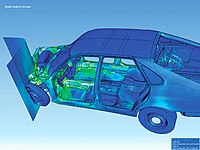
Photo from wikipedia
BackgroundStress relieving corticoto mies during the treatment of maxillary expansion are needed in adult patients.MethodsThree-dimensional (3D) finite element model was prepared, and finite element analysis was processed to evaluate the… Click to show full abstract
BackgroundStress relieving corticoto mies during the treatment of maxillary expansion are needed in adult patients.MethodsThree-dimensional (3D) finite element model was prepared, and finite element analysis was processed to evaluate the stress distributions within the skull and maxillary teeth during surgically assisted rapid maxillary expansion (SARME) treatment.ResultsExpansion forces generated more stress on the corticotomy-applied part of the maxilla. The stress levels decreased dramatically above the corticotomy line.ConclusionAsymmetric transveral maxillary expansion might be achieved from a symmetric force generating screw during SARME treatment. SARME osteotomies may concentrate the stress in the expanding maxilla and reduce the pain in other parts of the cranium.
Journal Title: Progress in Orthodontics
Year Published: 2018
Link to full text (if available)
Share on Social Media: Sign Up to like & get
recommendations!